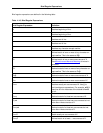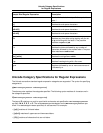
Brief Regular Expression Definition
X\:,n2? Minimal match of at least zero occurrences but not
more than n2 occurrences of X.
X\:n1,n2? Minimal match of at least n1 occurrences but not
more than n2 occurrences of X.
\(X\) Matches sub-expression X but does not define a
tagged expression.
{X} Matches sub-expression X and specifies a new
tagged expression. See Using Tagged Search Ex-
pressions for more information.
{@dX} Matches sub-expression X and specifies to use
tagged expression number d where 0<=d<=9. No
more tagged expressions are defined by the sub-
expression syntax {X} once this sub-expression
syntax is used. This is the best way to make sure
you have enough tagged expressions.
X|Y Matches X or Y.
[char-set] Matches any one of the characters specified by
char-set. A dash (-) character may be used to
specify ranges. The expression [A-Z] matches any
uppercase letter. Backslash (\) can be used inside
the square brackets to define literal characters or
define ASCII characters. For example, \- specifies a
literal dash character. The expression [\0-\27]
matches ASCII character codes 0..27. The expres-
sion []] matches a right bracket. In SlickEdit® regu-
lar expressions, [] matches no characters. In both
syntaxes, the expression [\]] matches a right brack-
et.
[~char-set] Matches any character not specified by char-set.
A dash (-) character may be used to specify ranges.
The expression [~A-Z] matches all characters ex-
cept uppercase letters. The expression [~] matches
any character except newline.
[char-set1 - [char-set2]] Character set subtraction. Matches all characters in
char-set1 except the characters in char-set2.
For example, [a-z-[qw]] matches all English lower-
case letters except q and w. [\p{L}-[qw]] matches
Brief Regular Expressions
533


















